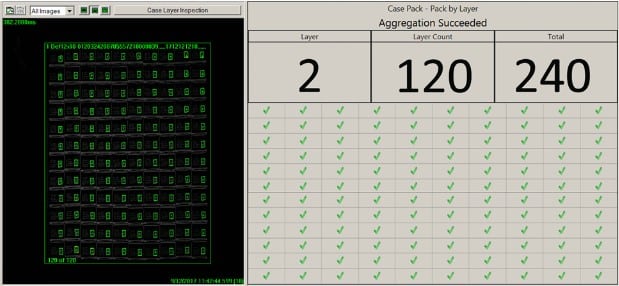Dans la deuxième partie de la série vision blogs, nous parlerons de Pack-By-Layer.
Emballage par couche est une solution d'agrégation dans laquelle tous les articles emballés dans une couche d'un paquet sont lus par le système de vision avec une seule image haute résolution. Cette solution présente de nombreux avantages pour les processus manuels, car elle évite aux opérateurs d'avoir à scanner manuellement chaque article avant de l'emballer, ce qui prend du temps et est source d'erreurs.
L'utilisation d'une caméra aérienne qui lit les données au fur et à mesure que vous emballez, et vous pouvez regarder l'écran pour vérifier le processus, semble être une opération beaucoup plus fiable et conviviale. Cela fonctionne également très bien avec les processus automatisés, car cela diminue les risques encourus, et il y a là une certaine histoire.
Avant que la technologie des caméras ne rattrape son retard, du point de vue de la résolution, toutes les agrégations étaient effectuées d'une sorte d'alimentation : lecture d'un élément à la fois, ou peut-être d'un groupe d'éléments qui constituent une rangée d'une couche - pas une couche entière, et par l'échange de signaux, l'agrégation de l'ensemble des éléments de l'image. sérialisation Le moteur peut suivre ces articles au fur et à mesure qu'ils sont formés en rangées, puis en couches et enfin placés ou poussés dans la caisse - ce qui suppose que tout ce qui a été lu et accepté à l'entrée se retrouvera dans la caisse. Cette méthode est généralement satisfaisante et fonctionne bien dans la majorité des situations... et même si ce n'était pas le cas, il n'y avait pas d'autre choix car il n'était pas possible de lire plus d'articles à la fois en raison des limitations de la résolution de la caméra.
Cette méthode d'alimentation comporte certains risques en raison des nombreux "imprévus" que le monde réel peut entraîner dans le processus d'encaissage :
Ce ne sont là que quelques-uns des éléments susceptibles de perturber le processus d'agrégation qui repose sur la lecture de l'alimentation. Bon nombre de ces risques pourraient être évités si la lecture de ce qui est emballé se faisait lorsque la couche est entièrement construite. La partie la plus difficile est l'aspect vision - s'assurer que c'est faisable maintenant que nous disposons de ces caméras sophistiquées.
La solution d'un Vision de Systech La perspective a fait l'objet d'améliorations itératives, chacune tirant les leçons de ce qui l'a précédée. Elle a été introduite en tant que nouvelle fonctionnalité dans notre outil de matrice de données existant pour lui permettre de lire en mode grille. Dès le départ, l'objectif était de faire descendre les détails de la grille (nombre de lignes x colonnes) du système Systech niveau 3 dans le cadre de la configuration du produit. Au fur et à mesure du déploiement des projets, les exigences et les défis d'une telle inspection de vision sont devenus beaucoup plus clairs, ce qui a conduit à la création d'un tout nouvel outil spécialement conçu pour la lecture d'une grille de codes matriciels avec des caractéristiques qui lui permettent de fonctionner dans cet environnement.

Ce nouvel outil, conçu sur mesure pour Pack-By-Layer, a été construit avec une fonctionnalité de formation différente qui a rendu l'inspection de chaque couche unique en ce qui concerne les spécificités de la façon dont l'outil trouve et lit les codes. Dans les opérations d'encaissage manuel ou automatisé par chargement par le haut, chaque couche est censée se trouver à une distance différente de la caméra, ce qui signifie que chaque couche aura des codes de taille différente des autres couches et que l'emplacement des codes dans l'image sera également différent au fur et à mesure que chaque nouvelle couche se rapproche de la caméra. Le fait que l'outil soit construit sur la base de cette théorie de fonctionnement permet de lire des codes plus petits, de travailler plus rapidement car l'outil sait mieux où attendre les codes dans chaque couche, et d'obtenir des taux de lecture plus élevés car il connaît également la taille des modules dans les codes de chaque couche.
C'est très bien, mais cela ne serait pas possible sans la capacité de recentrer automatiquement l'objectif lorsque ces nouvelles couches sont introduites - il a donc fallu innover sur le plan matériel pour mettre en œuvre les grandes idées du logiciel de vision. Lorsqu'une nouvelle couche est placée, le logiciel envoie des instructions de distance focale à un servomoteur fixé à la caméra qui ajuste la mise au point de l'objectif pour produire une image nette que l'outil de vision utilise pour lire les codes. C'est beau, c'est élégant, et cela fonctionne bien aussi, principalement grâce à l'innovation dans le domaine de la vision. Il ne s'agit pas d'une théorie, il y a des sites qui s'appuient sur ce système dans leurs opérations quotidiennes à haut volume, emballant de quelques cartons à des centaines de cartons par couche.
Pour en savoir plus sur cette solution innovante, Systech propose des services complets et polyvalents. les programmes de formation-Nous vous proposons une formation adaptée à votre niveau de connaissance et à vos objectifs, afin que chaque client soit parfaitement formé à nos puissantes solutions de vision, de sérialisation, de traçabilité et d'authentification. Consultez nos offres de cours actuelles ici.